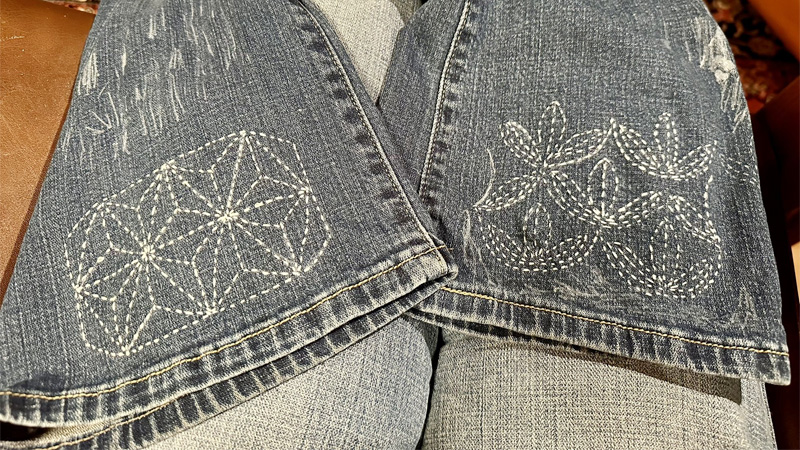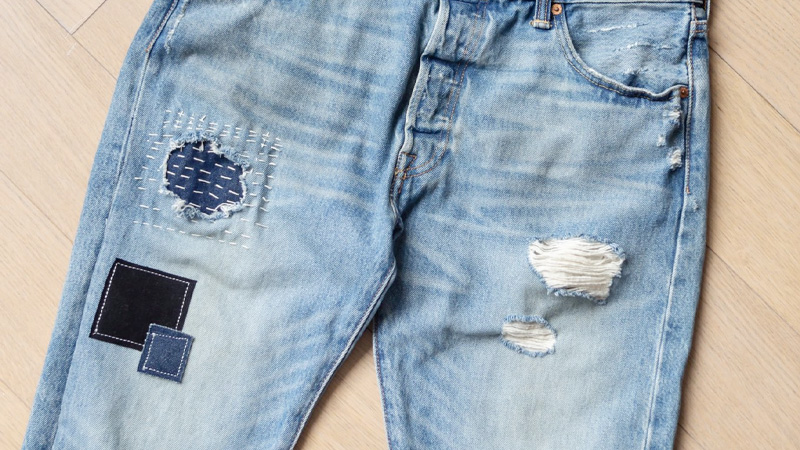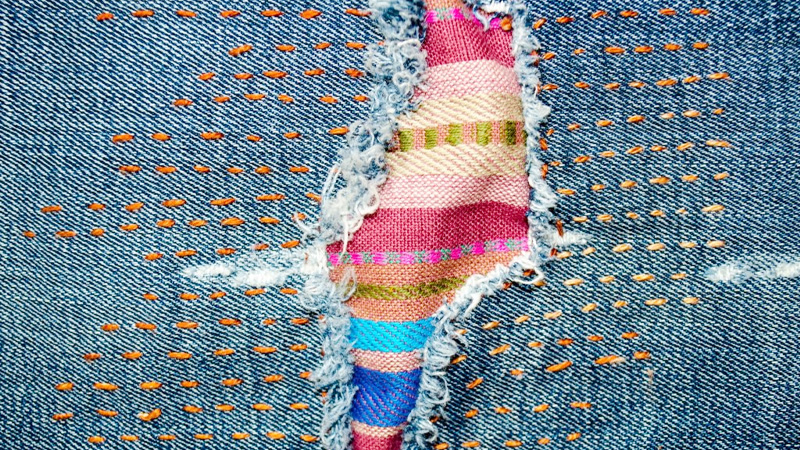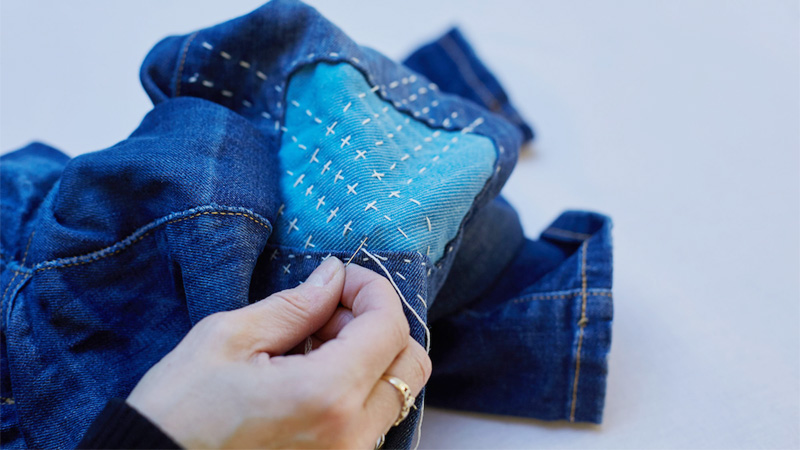Sashiko mending is a captivating and centuries-old Japanese art form that goes beyond merely repairing textiles; it transforms the act of mending into an artful expression of creativity and sustainability.
Rooted in the Japanese ethos of “mottainai,” which embodies the idea of minimizing waste and cherishing what we have, Sashiko mending offers a unique way to extend the life of your clothing while adding an exquisite touch of craftsmanship.
This traditional technique, characterized by its even running stitches and intricate geometric patterns, has gained global popularity as a form of “visible mending,” where the repairs themselves become celebrated features of the textile.
In this guide, we will explore how to sashiko mending and materials to the creative possibilities it offers. Whether you’re a seasoned Sashiko enthusiast or a newcomer intrigued by its beauty, this journey into the world of Sashiko mending promises to inspire and empower you to breathe new life into your textiles.

What Is The Sashiko Mending Technique?
Sashiko mending is a traditional Japanese embroidery technique that originated centuries ago as a method of reinforcing and repairing textiles, particularly worn-out or damaged garments.
The word “sashiko” translates to “little stabs” or “little pierce,” which aptly describes the technique. It involves using a simple running stitch, typically in a white thread on an indigo or other colored fabric, to create both functional and decorative repairs.
Sashiko stitches are characterized by their even spacing and geometric patterns, which not only strengthen the fabric but also transform the mended areas into beautiful design elements.
This method has gained popularity worldwide as a sustainable and artistic way to extend the life of clothing, breathe new life into vintage textiles, and embrace the ethos of “visible mending,” where the mending itself becomes a celebrated part of the garment’s story.
Sashiko mending exemplifies the fusion of functionality and aesthetics, making it a cherished skill in the world of textile art and sustainable fashion.
How To Sashiko Mending?

Here are the simple methods for Sashiko mending:
Gather Materials and Prepare Fabric:
Start by gathering your materials, including a piece of fabric that needs mending, Sashiko thread (typically white or a contrasting color), a Sashiko needle (long and sturdy), and a thimble if desired.
Prepare the fabric by washing and ironing it to ensure a flat surface for stitching.
Mark the Mending Area:
Identify the damaged or weakened area on the fabric. Use fabric chalk or a washable marker to mark the boundaries of the mending area. This will serve as your stitching guide.
Thread Your Needle:
Thread a length of Sashiko thread through the Sashiko needle, leaving a small tail. Traditionally, Sashiko thread is doubled, so you can either fold it in half or use a single strand, depending on the desired thickness of your stitches.
Begin Stitching with Running Stitches:
Start at one end of the marked mending area. Insert the needle from the back to the front of the fabric, leaving a small tail at the back. Pull the thread through until it stops at the tail.
Continue creating evenly spaced running stitches along the marked lines, ensuring they are of uniform length and evenly spaced.
Follow Traditional Sashiko Patterns:
While you can create simple running stitches, part of the beauty of Sashiko mending lies in the geometric patterns. Experiment with traditional Sashiko patterns like waves, diamonds, or parallel lines. These patterns not only reinforce the fabric but also add a decorative touch.
Secure the End of the Thread:
When you reach the end of your stitching line, secure the thread by making a small knot or weaving it through nearby stitches on the backside of the fabric. Trim any excess thread.
Repeat and Extend:
Continue stitching in this manner until you’ve covered the entire mending area. If needed, reinforce the fabric by adding another layer of stitches. Once complete, gently wash and press the fabric to help the stitches settle and blend with the surrounding material.
Sashiko mending is a versatile and visually appealing technique that not only mends clothing but also transforms it into a unique and artistic creation. With practice, you can explore various patterns and styles, making Sashiko mending a functional and beautiful way to extend the life of your textiles.
Supplies To Sashiko Mending?

Here are the essential supplies for Sashiko mending:
Fabric in Need of Repair
The primary material for Sashiko mending is the fabric that needs repair. This can be clothing, accessories, or textiles with holes, tears, or weak areas. Ensure the fabric is clean and well-prepared before starting your Sashiko project.
Sashiko Thread
Sashiko thread is a thick, durable, and often cotton thread used for Sashiko mending. It is available in various colors, but traditional Sashiko stitching is done with white or a contrasting color thread for a striking effect. The thread’s thickness provides both strength and visual impact.
Sashiko Needle
Sashiko needles are longer and sturdier than regular sewing needles, making them suitable for thick fabric and multiple layers. These needles have a large eye to accommodate the thick Sashiko thread. They come in different sizes, so choose one that suits your project.
Thimble (Optional)
While not essential, a thimble can be helpful, especially when working with tough or multiple layers of fabric. It protects your finger as you push the Sashiko needle through the material, making the stitching process more comfortable.
Marking Tools
Fabric chalk or a washable fabric marker is useful for marking the boundaries of the mending area on your fabric. These markings serve as a stitching guide, helping you maintain even stitches and patterns.
Scissors
Sharp fabric scissors are needed for cutting threads, trimming excess fabric, and neatly finishing your Sashiko mending project. Having a pair of small, precision scissors can be particularly helpful for detail work.
Ruler or Measuring Tape
For precision in creating straight lines and accurate spacing between stitches, a ruler or measuring tape is valuable. It helps ensure that your Sashiko stitches are evenly spaced and aligned according to your chosen pattern.
These essential supplies provide the foundation for successful Sashiko mending projects. By using the right materials and tools, you can create both functional and aesthetically pleasing repairs while preserving the history and character of your textiles.
Common Mistakes To Avoid When Doing Sashiko Mending?

Here are the common mistakes to avoid when doing Sashiko mending:
Uneven Stitch Lengths
One of the most noticeable mistakes in Sashiko mending is uneven stitch lengths. Irregular stitches can disrupt the visual appeal of your design.
To avoid this, take your time and ensure that your running stitches are of consistent length and spacing throughout your project.
Tight Stitching Tension
Pulling the Sashiko thread too tightly while stitching can lead to puckering and distortion of the fabric. It’s essential to maintain a moderate tension that allows for flexibility in the fabric. Your stitches should lie flat against the fabric, not pull it.
Ignoring Fabric Grain
Neglecting to align your Sashiko stitching with the fabric’s grain can result in a skewed and unprofessional appearance. Always make sure your stitches follow the grain lines, ensuring that they are straight and parallel to each other.
Inadequate Knots or Securing
Failing to secure the thread properly at the beginning and end of your stitching lines can lead to unraveling and incomplete repair. Knot the thread securely at the start and weave it through nearby stitches at the end to ensure it remains in place.
Skipping fabric Preparation
Working on dirty or wrinkled fabric can make Sashiko mending more challenging and less precise. Always start with clean, well-prepared fabric that has been properly ironed to create a smooth and even surface for stitching.
Overcomplicating Patterns
While Sashiko offers a variety of beautiful patterns, it’s easy to overcomplicate designs, especially for beginners. Start with simple patterns to get the hang of the technique before attempting more intricate designs. This will help you avoid frustration and errors.
Not Testing on Scrap Fabric
If you’re new to Sashiko or trying a new pattern, it’s a mistake to jump straight into your main project. Instead, practice on a scrap piece of fabric to refine your technique, test thread tension, and ensure you’re comfortable with the chosen pattern before applying it to your actual mending.
By being mindful of these common mistakes, you can enhance your Sashiko mending skills and create beautifully repaired and embellished textiles that showcase both functionality and artistry.
FAQs
What is Sashiko mending, and how does it differ from regular mending?
Sashiko mending is a traditional Japanese technique that involves repairing textiles through a series of even running stitches, often in a decorative pattern.
Unlike regular mending, which aims for an inconspicuous repair, Sashiko embraces the idea of “visible mending,” where the stitches themselves become part of the design. It not only strengthens the fabric but also adds an artistic and personalized touch to the repaired item.
What materials do I need for Sashiko mending?
To get started with Sashiko mending, you’ll need Sashiko thread (typically white or a contrasting color), a Sashiko needle (long and sturdy), fabric in need of repair, marking tools, scissors, and optionally a thimble for finger protection.
Can I use Sashiko mending for different types of fabric?
Yes, Sashiko mending can be used on various fabric types, including denim, cotton, linen, and more. The key is to choose a Sashiko thread and needle appropriate for the fabric’s thickness. Thinner fabrics may require lighter threads and needles, while heavier fabrics need thicker ones.
What are some beginner-friendly Sashiko patterns to try?
If you’re new to Sashiko, start with simple patterns like parallel lines, diamonds, or waves. These patterns are forgiving for beginners and provide a great foundation to build your skills. As you gain confidence, you can explore more intricate designs.
How can I care for Sashiko-mended garments?
Sashiko-mended garments can be cared for like any other clothing item. Gentle washing and air drying are recommended to preserve the stitches. If necessary, you can reinforce any loose stitches after washing, ensuring your Sashiko mending remains beautiful and functional for years to come.
Conclusion
Sashiko mending stands as a testament to the marriage of function and artistry, a reminder of the beauty that can be found in the act of repair.
In embracing this ancient Japanese technique, we’ve not only learned how to mend and strengthen our textiles but also discovered a means of personal expression and a sustainable approach to fashion.
The allure of Sashiko lies not only in its practicality but also in its ability to tell a story through stitches, transform a tear into a work of art, and foster a deeper connection with the garments we wear.
As we conclude our exploration of Sashiko mending, let us carry forward this profound appreciation for the craft, the history, and the values it embodies.
May your Sashiko journey continue to flourish, creating not only beautifully mended textiles but also a more mindful and sustainable relationship with the world of fashion.
Leave a Reply